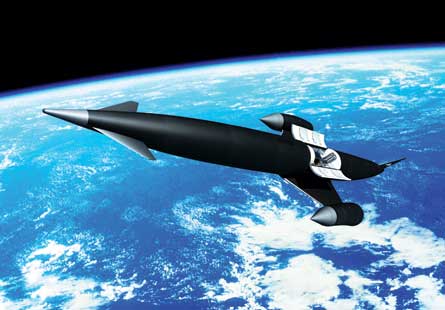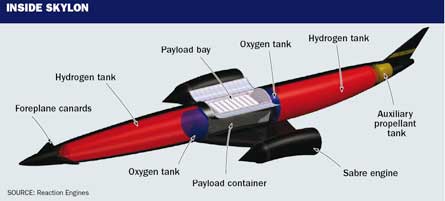Could the next space shuttle be a British machine? Don't laugh - if an ambitious rocket engine developer in Oxford has done its calculations, we could be just 10 years away from a reusable, runway take-off and landing unpiloted spaceplane, that promises to put payloads of up to 12t into orbit - and as much as 6t to a high geostationary orbit - for a tenth the cost of a traditional rocket launch.
As envisaged by its developers at Reaction Engines, Skylon's fuselage and wing load bearing structure will be made from carbonfibre-reinforced plastic, and its external shell from a fibre-reinforced ceramic, carrying only aerodynamic pressure loads, which are transmitted to the fuselage structure through flexible suspension points.
This shell - just 0.5mm thick and corrugated for stiffness - is free to move under thermal expansion, especially during the latter stages of the aerodynamic ascent and re-entry. At 87m (285ft) long and with a 25m wingspan, Skylon would be capable of carrying 10t to the International Space Station.
 |
|---|
© Reaction Engines |
Skylon's fuselage and wing load bearing structure will be made from carbonfibre-reinforced plastic |
Key to the success of Skylon is Reaction Engines' latest concept for a hybrid engine that breathes air in the atmosphere before switching to liquid hydrogen in space, to slash the fuel load needed to reach orbit. Tests on critical heat exchanger technology are set for this summer; the aim will be to cool Mach 5 air to -1500C (-2380F), a temperature low enough to liquefy oxygen for mixing with hydrogen to provide jet thrust. If the tests are successful, the project could get the green light for development.
RAISING THE CASH
At that point, Reaction Engines will be looking to raise $200 million to push development through to 2014, and ultimately $12 billion to achieve an operational model around 2020.
The business plan is then to sell craft for $1 billion each, with a forecast market of at least 30 machines.
For operators, Skylon promises recurring costs of just $10 million per flight. And, if it gets off the ground, the design allows for a 30-passenger cabin to be fitted in the payload bay.
 |
|---|
The configuration of Skylon bears no small resemblance to a European Union-sponsored concept for hypersonic, suborbital transport called Lapcat, which Reaction Engines is involved in and which readers of Dan Brown's anti-matter blockbuster Angels and Demons will recognise as the machine sent by the boffins at CERN to collect symbologist Robert Langdon from his Harvard redoubt and bring him to Geneva - in 40min.
Those with a longer memory may also recall the UK government-sponsored HOTOL spaceplane project of the 1980s - Reaction Engines' managing director Alan Bond worked on that project too, patenting an engine concept suitable for so-called single-stage-to-orbit flight.
Is Reaction Engines following in Concorde's footsteps? David Learmount considers it
Source: Flight International



















